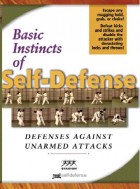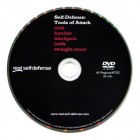Stabs are faster than slashes and an untrained person can easily stab at a rate of four stabs per second
In 1996 emergency departments in the U.S.A. reported treating 112,710 injuries inflicted by cutting or puncturing weapons. Of those victims, 5,352 died. Puncture wounds caused 4,832 of these deaths and slashes the remaining 520. Add these statistics to the practical observation that stabs are faster than slashes and easier to do in a “rapid-fire” series, and you should conclude that this is a type of attack you should practice defenses against.
Short, edged weapons are very efficient. They do not require large and strong movements, raising the arm or drawing it back before striking. All the strength required to stab someone is the strength of a push, and an untrained person can easily stab at a rate of four stabs per second. To make things worse, all body parts are good targets. A stab to the hand or arm may disable it and open up lethal targets on the trunk, thighs, neck, and face.
So what defenses are there against such attacks? Give your partner a marker, put on some protective pads yourself (a stab with a marker can cause serious injury, too), and see what you can do. You will not have much chance of deflecting the “weapon” because of the speed of the attacker’s light, non-committing movements. Kicking the knife-wielding attacker will likely result in a series of stabs and cuts to the leg that can be either lethal or crippling for life — again because all it takes is for him or her to redirect a light movement of the blade to your leg, a movement that would be too weak and too high to deflect your kick with an empty hand. Grabbing either hand of the attacker without getting badly cut is not likely either.
You will learn that unless you can prevent your attacker from drawing out the weapon, your best defense is to gain distance, put obstacles between you and the attacker. After you put more than 5 yards between you and the attacker or are behind an obstacle that will slow the attacker down for a few seconds, the best defense against an edged weapon attack is a gun. If you are unarmed because it is illegal for you to have the means of self-defense — your right to self-defense is violated — you will have to improvise and use objects within your reach to defend yourself. You may just get lucky. A stick may match the speed of a knife, thrown stones can stop the attacker, dirt or clothes thrown in the face may disorient him or her for a moment.
Self-defense tip from Thomas Kurz, co-author of Basic Instincts of Self-Defense and author of Science of Sports Training, Stretching Scientifically, and Flexibility Express.
Self-Defense Moves
For your defense moves to work under stress they must be based on your natural, instinctive reactions, require little strength and limited range of motion, and be proven in fighting experience.To learn how your natural reactions can instantly defeat any unarmed attack, see the video Basic Instincts of Self-Defense.
Defend Against Weapons
To defend against weapons you have to know how they are used. Also — every stick has two ends … the weapon of attack may become a weapon of defense in your hand …To learn how the typical street weapons (club, knife, razor) are used by an experienced streetfighter and how to practice with them, see the video Self-Defense: Tools of Attack — Club, Hatchet, Blackjack, Knife, Straight Razor.
Mental Toughness
Staying cool under pressure is more important for self-defense than being physically fit and technically skilled. If you can’t control your mind what can you control?To learn mental techniques that let you calmly face any threat and act rationally in the heat of a fight, click here.
For a complete list of our products, click here.







